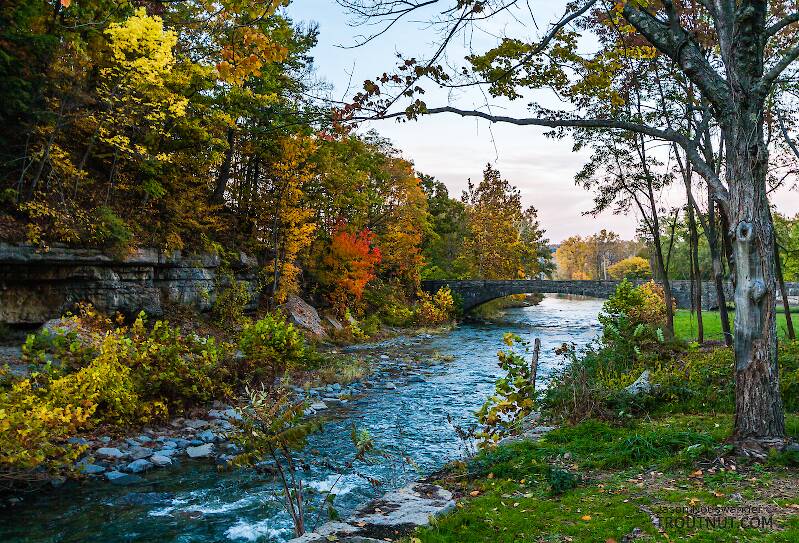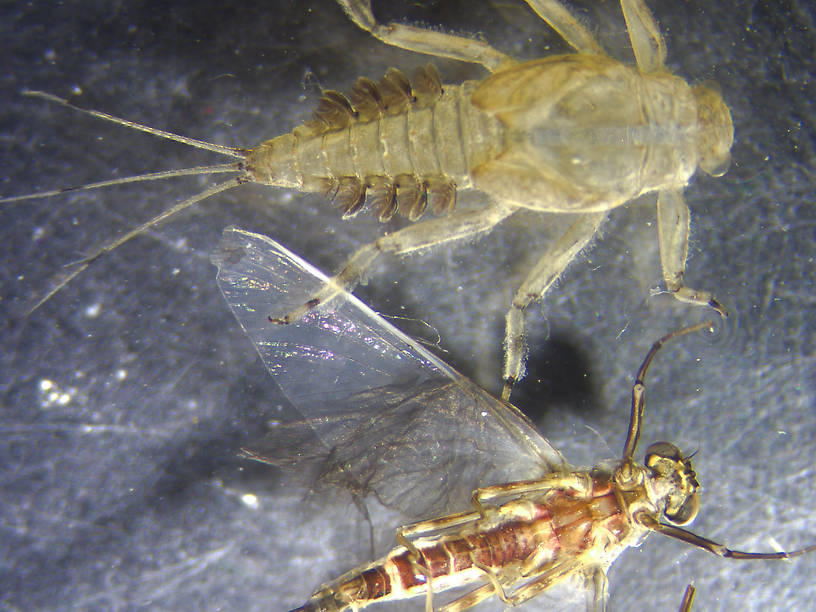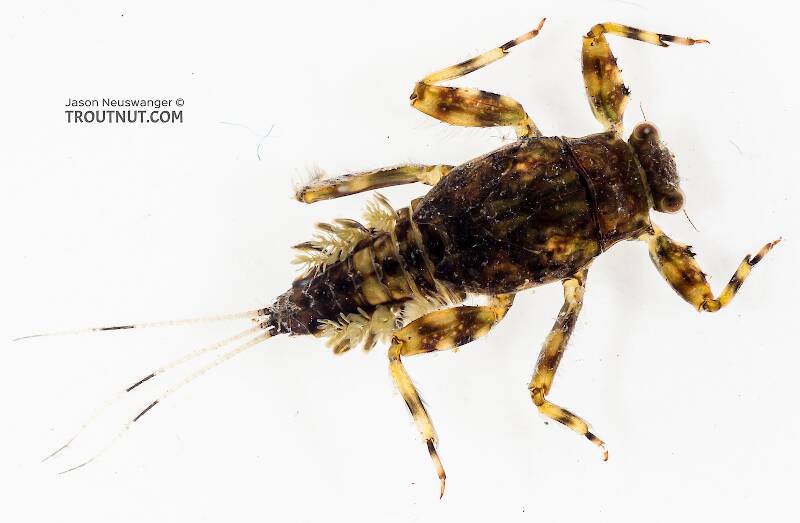
Salmonflies
Pteronarcys californica
The giant Salmonflies of the Western mountains are legendary for their proclivity to elicit consistent dry-fly action and ferocious strikes.
Featured on the forum

Troutnut is a project started in 2003 by salmonid ecologist Jason "Troutnut" Neuswanger to help anglers and
fly tyers unabashedly embrace the entomological side of the sport. Learn more about Troutnut or
support the project for an enhanced experience here.
Slate-Winged Olives
Like most common names,"Slate-Winged Olive" can refer to more than one taxon. They're previewed below, along with 7 specimens. For more detail click through to the scientific names.
Mayfly Species Attenella attenuata
These are sometimes called Slate-Winged Olives.
This intriguing species has received a lot of attention in past angling books. Recent authors suspect that much of this credit was a case of mistaken identity, with Attenella attenuata receiving praise for the hatches of Drunella lata and Dannella simplex. Much of the credit was legitimate and accurate, but this species is no longer thought to be on par with its most popular cousins in Ephemerella and Drunella.
I have several specimens listed under this species, but I'm not positive the identification is correct.
I have several specimens listed under this species, but I'm not positive the identification is correct.
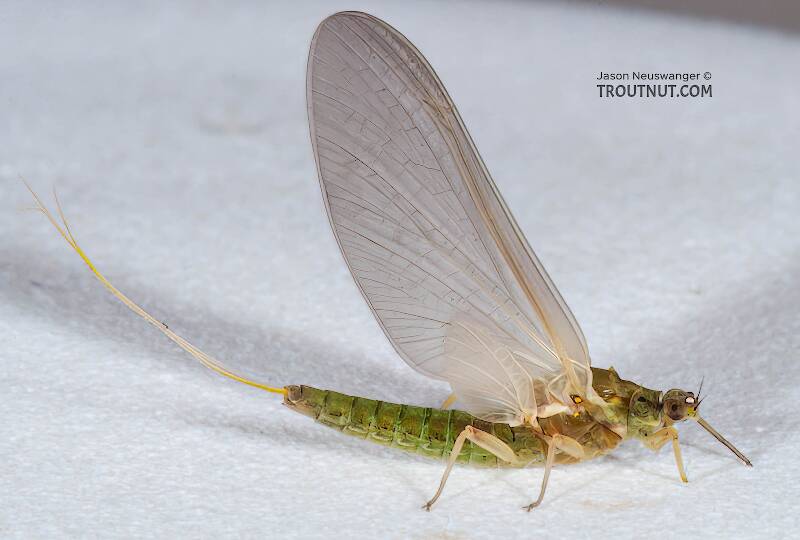
This specimen came from the same hatch as a male.
See 2 more specimens...
Mayfly Species Drunella coloradensis
These are sometimes called Slate-Winged Olives.
This species is very similar to Drunella flavilinea. In areas where their ranges overlap, they can sometimes be found in the same streams. They are similar enough that anglers sometimes refer to either or both species as "Flavs." Allen and Edmunds (1962) say that Drunella coloradensis tends to favor colder water than Drunella flavilinea and that it may emerge as much as a month later.
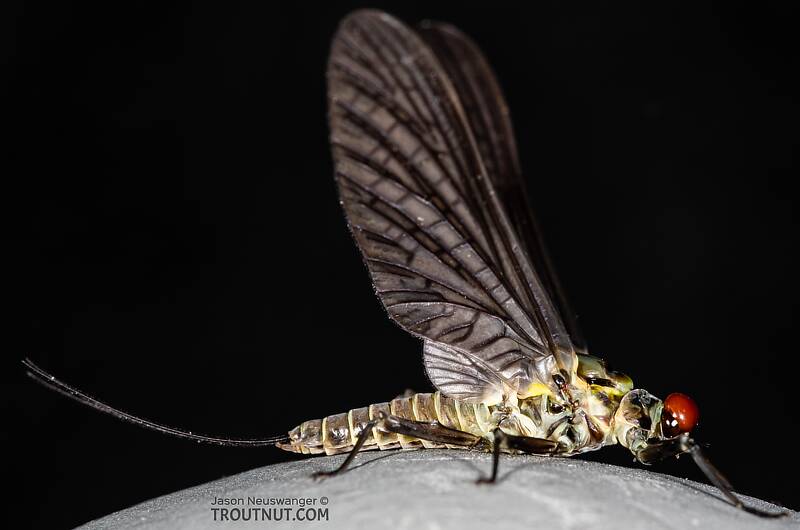
The positive species ID on this dun comes from both the spinner that it (or possibly one other dun just like it) molted into and the overwhelming abundance of nymphs of this species in my kicknet samples from the same site.
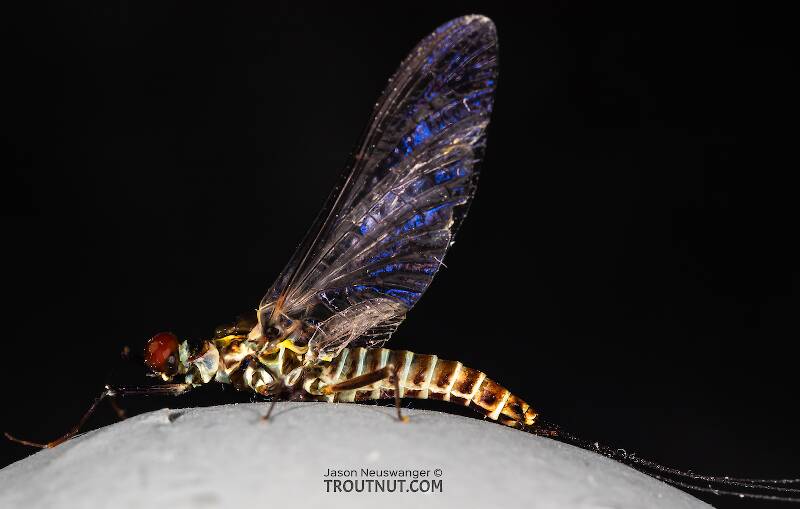
This spinner molted from this dun, or possibly one other dun I had in the same container that looked just like it.

This one nicely illustrates the variation in coloration within an single Ephemerellid species in a single stream, when compared to its lighter, banded counterpart.
See 7 more specimens...
Mayfly Species Baetis intercalaris
These are sometimes called Slate-Winged Olives.
Mayfly Species Drunella flavilinea
These are very rarely called Slate-Winged Olives.
The Flavs pick up about a week after the closely related but larger Western Green Drakes (Drunella grandis and Drunella doddsii) finish hatching on most Western waters.
Their hatches may be complemented by simultaneous hatches of two less prolific species, Drunella coloradensis and Drunella spinifera.
Their hatches may be complemented by simultaneous hatches of two less prolific species, Drunella coloradensis and Drunella spinifera.
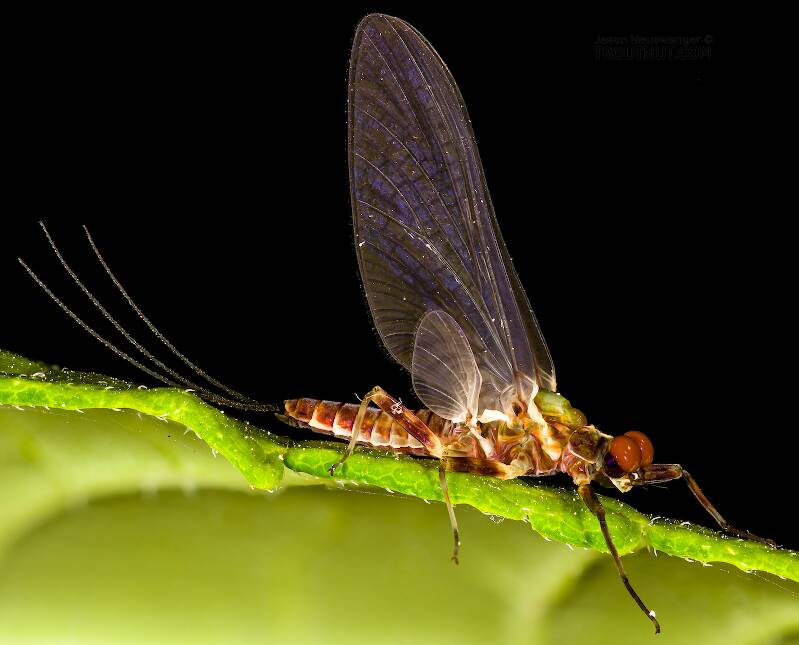
This dun is smaller than would normally be expected for Drunella flavilinea, but it seems to fit the physical description of that species fairly well. I wasn't sure from the dun pictures alone, so I was hoping it would molt into a spinner. It never made it out of the dun's shuck, but it did begin the process, which allowed me with great care to tease out the last couple abdominal segments of the spinner from the still tightly attached dun shuck, enabling a more confident ID based on the shape of the spinner's penes and sub-genital plate. I also collected a nymph of flavilinea in the same river on the same evening, as well as a shed exuvium that looked large enough to belong to an emerging dun.
The other possibility I considered for a while based on the dun was Drunella pelosa, which would be the right size, but the other characteristics don't fit.
The other possibility I considered for a while based on the dun was Drunella pelosa, which would be the right size, but the other characteristics don't fit.
See 2 more specimens...
Mayfly Species Drunella lata
These are very rarely called Slate-Winged Olives.
When Selective Trout was first published in 1971, Swisher and Richards included Drunella lata (Small Blue-Winged Olive, Slate-Winged Olive) as a Midwestern "superhatch." Although it can also be found in many Eastern trout streams, it is probably more important to Midwestern anglers. Typically a morning emerger, this species often competes for the attention of trout with more abundant Tricorythodes and small baetids during parts of July and August. For this reason, the authors of Selective Trout considered the concentrated evening spinner falls to be more important than the somewhat sporadic morning emergence. From an angling standpoint, this situation is nearly the opposite of the earlier Drunella cornuta emergence in the East, where the morning emergence is usually the main event and spinner falls are often of little consequence.
Currently, Drunella lata shares its name with another mayfly, the former D. longicornis. That mayfly can be important in mountainous areas in the Southeast, but they are larger and the nymphs lack the distinctive pale markings mentioned in the Juvenile Characteristics section. (The information on this page does not describe D. longicornis)
Currently, Drunella lata shares its name with another mayfly, the former D. longicornis. That mayfly can be important in mountainous areas in the Southeast, but they are larger and the nymphs lack the distinctive pale markings mentioned in the Juvenile Characteristics section. (The information on this page does not describe D. longicornis)
Mayfly Species Labiobaetis propinquus
These are very rarely called Slate-Winged Olives.
This species was previously known as Baetis propinquus, a name from older nomenclatures and angling literature familiar to many western anglers. Prior to its current listing, it did a brief stint in the genus Pseudocloeon. The irony is that though this species has hind wings, it was the last species remaining in Pseudocloeon (before the genus recent Nearctic taxonomic demise) which was best known for its species lacking hind wings as an identifying character.
Though it has a national distribution its most important hatches occur in the West, usually hatching between the larger broods of Baetis tricaudatus. Western anglers experiencing a hatch can easily confuse them with the larger Baetis bicaudatus as both nymphs appear similar with only two tails. Besides size, the adults can be separated from bicaudatus (with the help of a little magnification) because L. propinquus lacks acute costal projections on its tiny hind wings. Conversely, the presence of hind wings and lack of conical mesonotal projections makes them easy to tell from the more common and equally tiny Acentrella turbida.
Though it has a national distribution its most important hatches occur in the West, usually hatching between the larger broods of Baetis tricaudatus. Western anglers experiencing a hatch can easily confuse them with the larger Baetis bicaudatus as both nymphs appear similar with only two tails. Besides size, the adults can be separated from bicaudatus (with the help of a little magnification) because L. propinquus lacks acute costal projections on its tiny hind wings. Conversely, the presence of hind wings and lack of conical mesonotal projections makes them easy to tell from the more common and equally tiny Acentrella turbida.
References
- Swisher, Doug and Carl Richards. 2000. Selective Trout. The Lyons Press.

